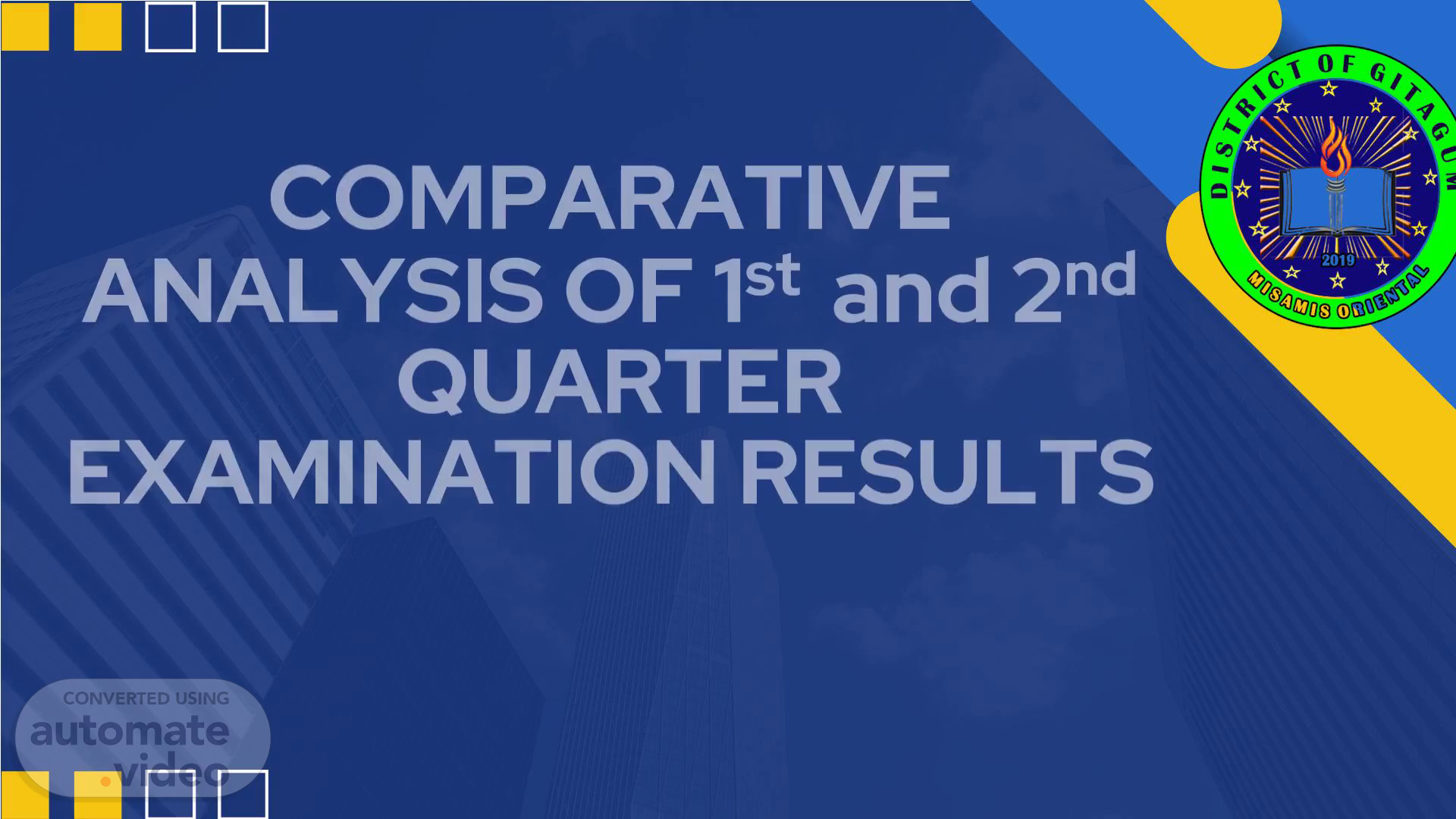Scene 1 (0s)
[Audio] COMPARATIVE ANALYSIS OF 1st and 2nd QUARTER EXAMINATION RESULTS GITAGUM DISTRICT.
Scene 2 (8s)
[Audio] Presented by : Marcel J. Tagalogon District-In-Charge November 13, 2025.
Scene 3 (19s)
[Audio] Objectives of the Presentation To share and compare the results of the First and Second Quarter examinations across all grade levels (Grades 1–10), highlighting key trends and the overall performance of the district. To examine student performance by learning area, identifying which subjects showed notable improvement and which areas may need additional support and attention. To recognize students’ strengths in literacy and values education—particularly in Reading, Language, and GMRC—and to pinpoint areas for growth in English, Mathematics, and Science, where critical thinking and problem-solving skills play a vital role. To explore performance differences across grade levels, assessing how consistently students performed between the two quarters. To propose actionable strategies and interventions that can help improve learning outcomes, such as tailored instruction, enrichment and remediation programs, and targeted support in English, Math, and Filipino, ensuring continuous and balanced academic progress for all learners..
Scene 4 (1m 27s)
[Audio] data coverage Number of schools: 12 Total learners assessed: 2,593 Grade levels covered: Grades 1–10 📘 Learning Areas Analyzed -English, Filipino, Mathematics, Science, Araling Panlipunan, MAPEH, EPP/TLE , Makabansa, GMRC.
Scene 5 (1m 50s)
[Audio] data coverage Comprehensive assessment conducted across all 12 schools. Data gathered from SF1 (School Register), SF4 (Monthly Learner Movement and Attendance Report), test papers, and District Summary of Test Results Results provide insights into learner performance, progress, and areas for instructional improvement Findings support evidence-based planning for the next grading period.
Scene 6 (2m 19s)
[Audio] overall performance summary. Level Elementary (1—6) Junior High (7—10) District Overall (1—10) Quarter 1 Average (%) 65.83 59.94 63.47 Quarter 2 Average (%) 68.92 63.13 66.60 Change (%) +3.09 +3.19 +3.13.
Scene 7 (2m 31s)
[Audio] overall performance summary Key Insight The District Average increased from 63.47% to 66.60%, showing an overall improvement of +3.13%. Both Elementary and Junior High levels demonstrated consistent gains, indicating positive academic growth across all grade levels..
Scene 8 (2m 54s)
[Audio] comparative analysis by grade level. comparative analysis by grade level.
Scene 9 (3m 0s)
[Audio] comparative analysis by grade level. comparative analysis by grade level.
Scene 10 (3m 7s)
[Audio] . comparative analysis by grade level.
Scene 11 (3m 13s)
[Audio] . comparative analysis by grade level.
Scene 12 (3m 19s)
[Audio] . comparative analysis by grade level.
Scene 13 (3m 25s)
[Audio] comparative analysis by learning area. comparative analysis by learning area.
Scene 14 (3m 33s)
[Audio] comparative analysis by learning area. comparative analysis by learning area.
Scene 15 (3m 40s)
[Audio] cross-analysis. cross-analysis.
Scene 16 (3m 47s)
[Audio] Cross Analysis: When comparing the subjects, the data shows distinct performance gaps between language-based and analytical subjects. Highest Performance: Reading and Literacy (79.21) and Language (75.59) — indicates strength in verbal comprehension, vocabulary, and reading skills. Moderate Performance: Makabansa (72.77) and GMRC (70.17) — shows understanding of values and national awareness. Lowest Performance: English (58.99) and Science (60.94) — suggests challenges in comprehension of English texts and application of scientific concepts..
Scene 17 (4m 38s)
[Audio] . [image] Strength Area: Literacy and native language proficiency are well-developed, showing strong communication and reading comprehension skills. Weakness Area: English and Science show significant gaps; these subjects rely heavily on abstract reasoning and technical vocabulary, possibly contributing to lower results. Balanced Area: Social and values-oriented subjects (Makabansa, GMRC, Araling Panlipunan) are consistent, indicating positive attitudes and general knowledge..
Scene 18 (4m 57s)
[Audio] Interpretation of Results Overall, the student exhibits strong literacy and moral understanding, but needs targeted intervention in English, Science, and Mathematics to improve logical reasoning and critical thinking. The wide range (from 58.99 to 79.21) indicates inconsistency in academic performance across subjects. This could reflect differences in learning style preference — stronger in verbal and contextual learning, weaker in analytical and technical learning..
Scene 19 (5m 33s)
[Audio] .
Scene 20 (5m 38s)
[Audio] .
Scene 21 (5m 44s)
[Audio] .
Scene 22 (5m 50s)
[Audio] conclusion All subjects reflected modest increases in performance, suggesting that intervention measures and continued instruction have had a positive, though limited, impact. The results imply that teaching strategies, remediation activities, and student engagement efforts contributed to the improvement, though further enhancement in teaching and learning support is still needed to achieve significant progress. Overall, the data suggest a positive direction of learner performance with room for further improvement through continuous academic support, targeted interventions, and effective monitoring of student outcomes..
Scene 23 (6m 29s)
[Audio] PLAN OF ACTION Key Findings / Issues Objectives Strategies / Activities Persons Involved Time Frame Expected Outcome 1. Slight improvement in learners’ performance across all subject areas To sustain and further improve learners’ academic performance Conduct enrichment classes during vacant periods or after class hours Subject Teachers, Learners November–December 2025 Increased mastery of competencies and higher scores in the next quarter 2. Learners’ difficulty in comprehension and problem-solving skills To enhance learners’ reading comprehension and analytical skills Implement Reading Intervention Program (“Read and Solve Everyday”); integrate problem-solving drills in all subjects English, Filipino, Math Teachers Continuous (Weekly) Improved comprehension and problem-solving performance 3. Lack of active parental involvement in monitoring learners’ progress To strengthen home-school partnership Conduct parent-teacher conferences and orientation on learners’ performance and study habits Class Advisers, Parents, Head Teacher Every End of Quarter Increased parental support and monitoring of learners 4. Need for teachers’ continuous professional development To enhance teachers’ instructional skills and assessment practices Conduct Learning Action Cell (LAC) sessions and peer mentoring School Head, Master Teachers Monthly Improved teaching competence and effective classroom management.
Scene 24 (8m 8s)
[Audio] THANK YOU. THANK YOU.
